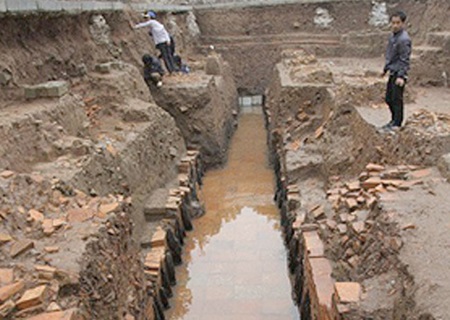Previously, scientists had only found relics from two dynasties at Thang Long Royal Citadel, but this year they had a major breakthrough when they were able to identify objects from several more dynasties at the historical site.
 |
| Flowing through time: Archaeologists have found part of a large drainage system under the Thang Long Royal Citadel from the Ly dynasty. — Photo courtesy of the Thang Long-Hanoi Heritage Conservation Centre |
Archaeologists announced the news on December 16 in Hanoi while reviewing excavations from 2014.
Scientists have found architectural traces of the Ly (1009-1225), Tran (1225-1400), Le (1428-1527) and Nguyen (1802-1945) dynasties.
Vestiges of Later Le Dynasty were also discovered. Le dynasty began in 1428, with the coronation of Le Loi after he drove the Chinese Ming army from the country.
"These discoveries show the great multifaceted value of the Thang Long Royal Citadel relics," said Tong Trung Tin, director of Vietnam Archaeology Institute. "They also prove the variety, uniqueness and profoundness of the artefacts.
"Now we have an overview of architectural research at the royal citadel. We have found traces of the building's foundation and tiled court yard from the Ly dynasty. Many scientists believe the courtyard was used for royal meetings."
Archaeologists unearthed a large water drainage system in 2012, paved with red bricks and lined with wooden poles. They thought it originated in the Tran dynasty, but evidence collected recently has shown it was actually made during the Ly dynasty.
The Thang Long Royal Citadel relics require further excavation, and archaeologists need more money and researchers so they can widen the excavation area and explore further, Tin said.
"During 2014, we excavated an area of about 1,000sq.m," he said. "If we maintain our speed, we may need another century to uncover the whole citadel."
Preserving history
History professor Phan Huy Le said that now archaeologists can recognise the difference between architecture made during different periods in Vietnamese history.
He also said Vietnam must work to preserve the archaeological sites and artefacts.
"Thang Long Royal Citadel is a very complicated site, with many cultural layers from many periods," he said. "That's why specialists and cultural managers should be careful when digging in the heritage site."
Historian Nguyen Thi Lien said archaeologists should be respectful, and follow specific methods to safeguard the buildings while excavating under them.
"It's regretful if we damage an old house or Opera House to dig out what's beneath them," she said. "We have to find a way to continue archaeological research but still preserve the constructions above."
Kinh Thien Palace sits in the centre of Thang Long Citadel. Built in 1428, it is believed it was the most important building and hosted many royal ceremonies.
The citadel was built in the 11th century during the Ly dynasty, to mark the independence of Dai Viet, the former name. The central sector of the imperial citadel was listed in UNESCO's World Heritage Site on July 31, 2010.
No comments:
Post a Comment